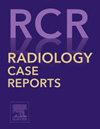Coexistence of a right vertebral artery originating from the right common carotid artery, an aberrant right subclavian artery and a left primitive proatlantal intersegmental artery: First case report
Q4 Medicine
引用次数: 0
Abstract
There are no reports of the coexistence of a right vertebral artery (VA) originating from the right common carotid artery (CCA), an aberrant right subclavian artery (SCA) and a primitive proatlantal intersegmental artery (PPIA); thus, we report such a case. A 61-year-old female presented with subarachnoid hemorrhage. Computed tomography angiography (CTA) and digital subtraction angiography (DSA) revealed a ruptured right posterior communicating artery (PcomA) aneurysm. The PcomA aneurysm was successfully embolized, and the patient recovered well. Moreover, CTA and DSA revealed that the right VA originated from the right CCA instead of the right SCA. The right SCA was aberrant from the aorta, a PPIA originated from the left external carotid artery and extended posteriorly into the left C1 transverse foramen to connect with the left intracranial VA, and the left extracranial VA was hypoplastic. Our report contributes to the literature concerning the rare variation in the origins of larger vessels located above the aorta. In addition, in our report, the complex anatomy of the neck vessels made establishing a path to access intracranial aneurysms difficult.
求助全文
约1分钟内获得全文
求助全文
来源期刊

Radiology Case Reports
Medicine-Radiology, Nuclear Medicine and Imaging
CiteScore
1.10
自引率
0.00%
发文量
1074
审稿时长
30 days
期刊介绍:
The content of this journal is exclusively case reports that feature diagnostic imaging. Categories in which case reports can be placed include the musculoskeletal system, spine, central nervous system, head and neck, cardiovascular, chest, gastrointestinal, genitourinary, multisystem, pediatric, emergency, women''s imaging, oncologic, normal variants, medical devices, foreign bodies, interventional radiology, nuclear medicine, molecular imaging, ultrasonography, imaging artifacts, forensic, anthropological, and medical-legal. Articles must be well-documented and include a review of the appropriate literature.
 求助内容:
求助内容: 应助结果提醒方式:
应助结果提醒方式:


